Unit 2 Great people Grammar 教学课件 (共20张PPT)
文档属性
| 名称 | Unit 2 Great people Grammar 教学课件 (共20张PPT) | 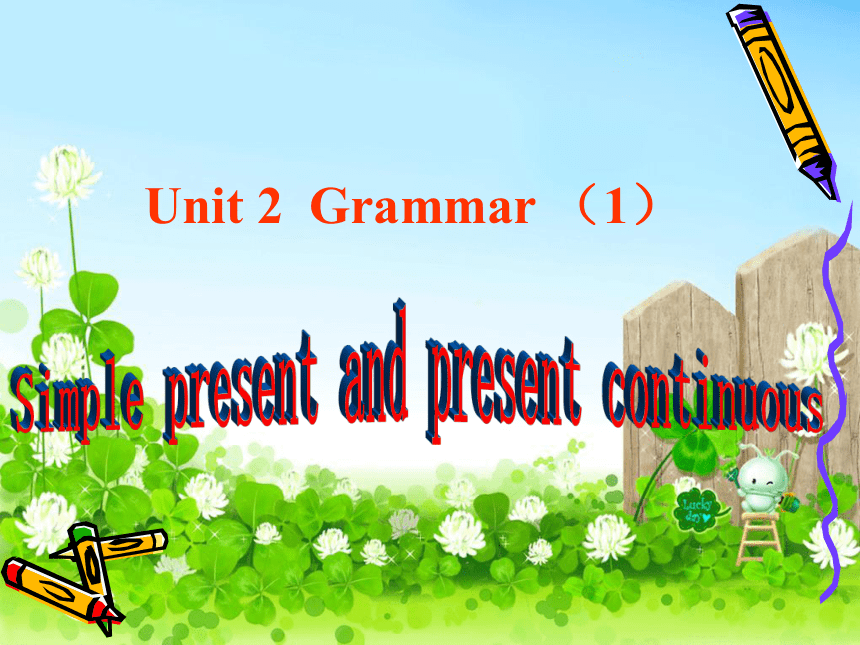 | |
| 格式 | zip | ||
| 文件大小 | 1.3MB | ||
| 资源类型 | 教案 | ||
| 版本资源 | 牛津译林版 | ||
| 科目 | 英语 | ||
| 更新时间 | 2020-01-07 12:43:33 | ||
图片预览

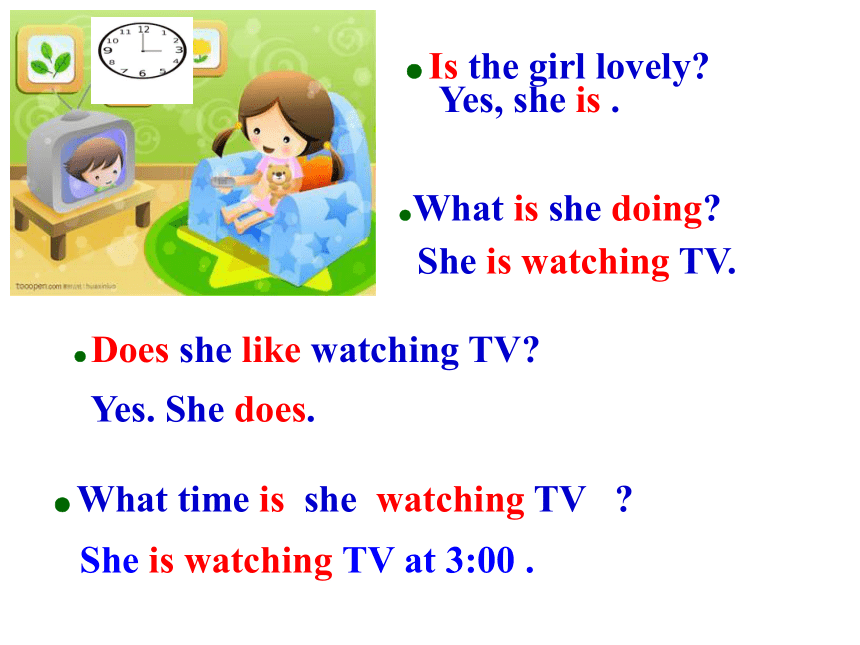
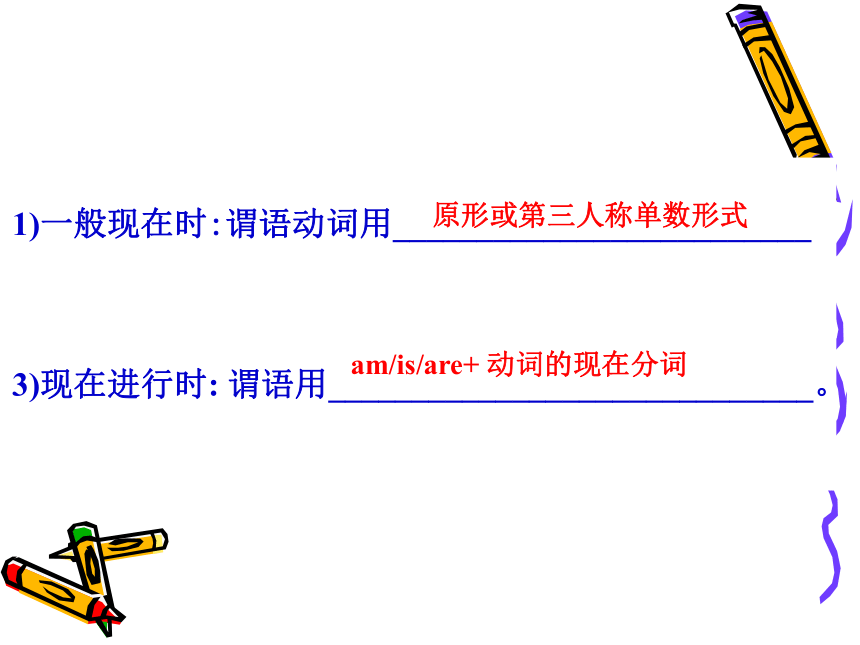
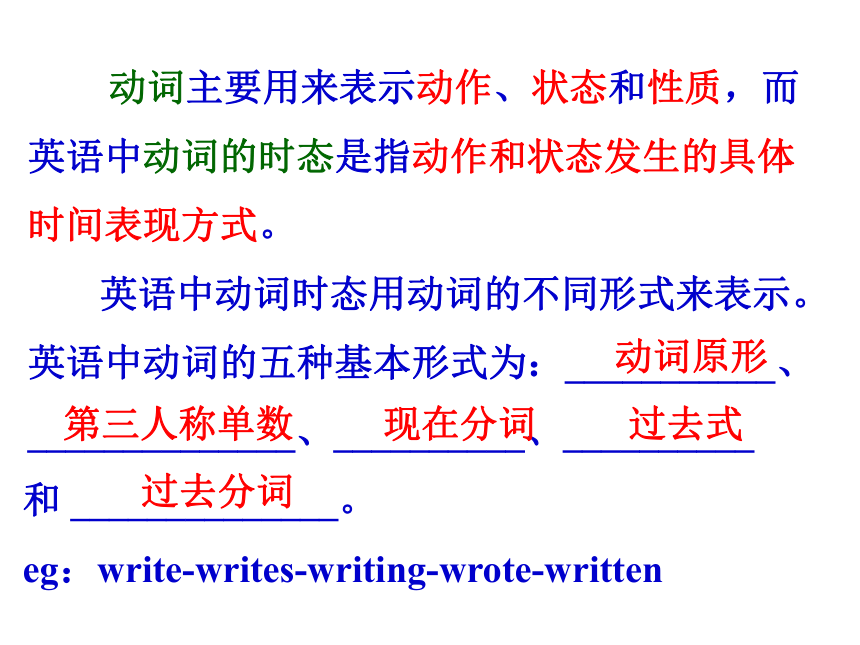
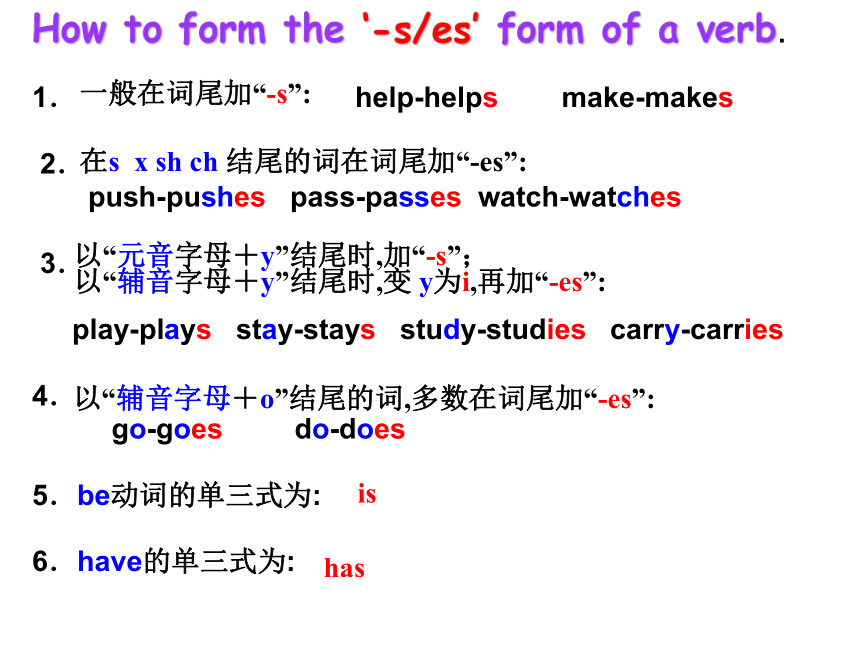

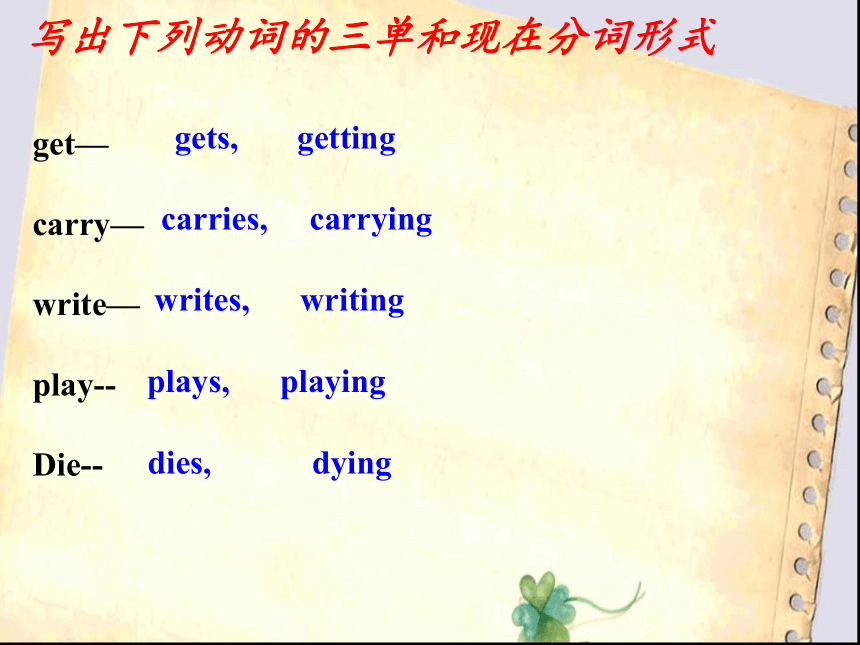
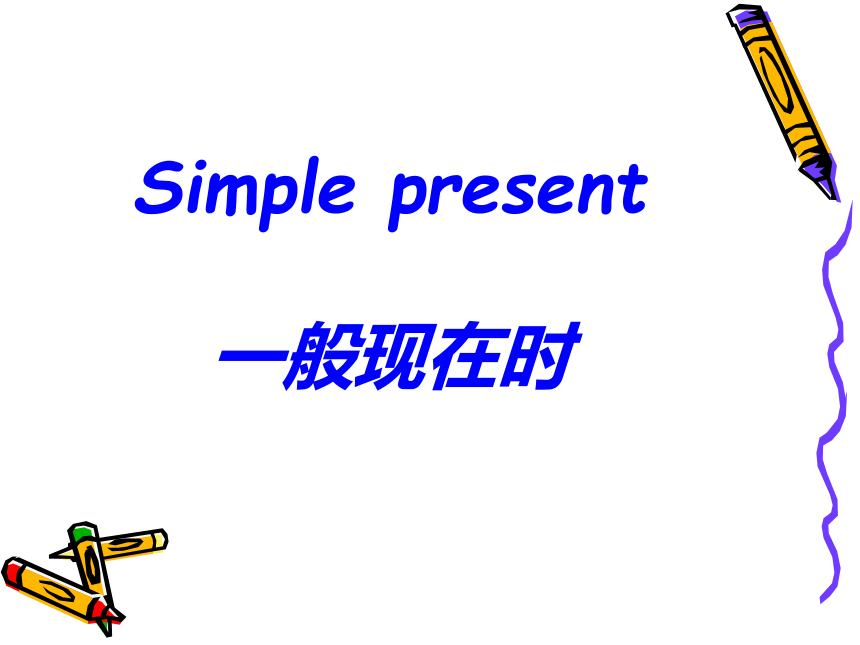
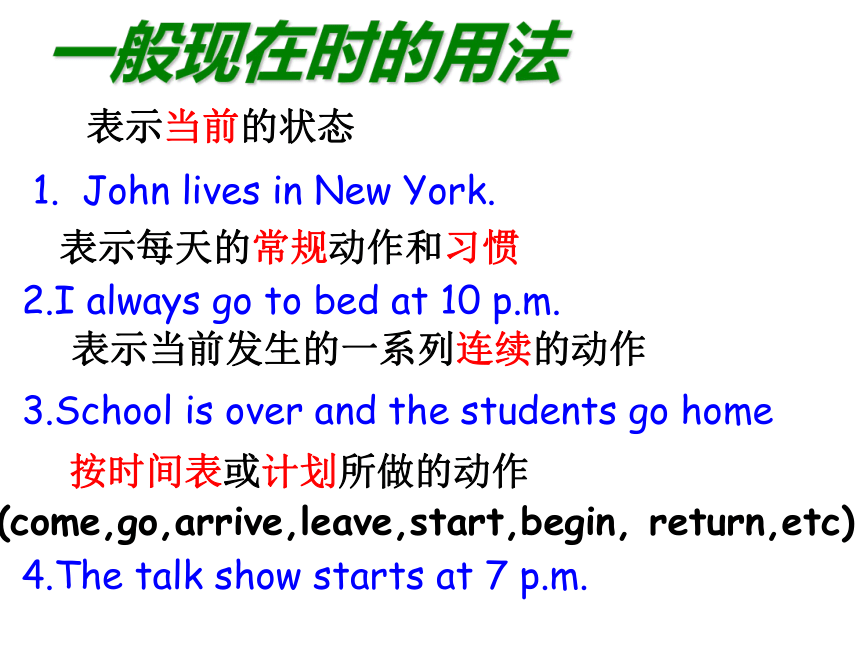
文档简介
(共20张PPT)
Unit 2 Grammar (1)
●What is she doing?
She is watching TV.
● Does she like watching TV?
Yes. She does.
● Is the girl lovely?
Yes, she is .
● What time is she watching TV ?
She is watching TV at 3:00 .
1)一般现在时:谓语动词用_________________________
3)现在进行时: 谓语用_____________________________。
原形或第三人称单数形式
am/is/are+ 动词的现在分词
动词主要用来表示动作、状态和性质,而英语中动词的时态是指动作和状态发生的具体时间表现方式。
英语中动词时态用动词的不同形式来表示。英语中动词的五种基本形式为:___________、______________、__________、__________
和 ______________。
eg:write-writes-writing-wrote-written
动词原形
第三人称单数
现在分词
过去式
过去分词
How to form the ‘-s/es’ form of a verb.
1. help-helps make-makes
2.
push-pushes pass-passes watch-watches
3.
play-plays stay-stays study-studies carry-carries
4.
go-goes do-does
5.be动词的单三式为:
6.have的单三式为:
一般在词尾加“-s”:
在s x sh ch 结尾的词在词尾加“-es”:
以“元音字母+y”结尾时,加“-s”;
以“辅音字母+y”结尾时,变 y为i,再加“-es”:
以“辅音字母+o”结尾的词,多数在词尾加“-es”:
is
has
How to form the ‘-ing’ form of a verb.
walking
coming
lying
running
直接+ing
去e+ing
-ie变y+ing
重读闭音节(两辅夹一元) 双写最后一个字母+ing
Most verbs walk
Verbs ending in e come
Verbs ending in ie lie
Short verbs ending in a vowel + a consonant run
写出下列动词的三单和现在分词形式
get—
carry—
write—
play--
Die--
gets, getting
carries, carrying
writes, writing
plays, playing
dies, dying
Simple present
一般现在时
一般现在时的用法
1. John lives in New York.
2.I always go to bed at 10 p.m.
3.School is over and the students go home
4.The talk show starts at 7 p.m.
表示当前的状态
表示每天的常规动作和习惯
表示当前发生的一系列连续的动作
按时间表或计划所做的动作
(come,go,arrive,leave,start,begin, return,etc)
Tip:
The teacher told the students that the earth is round.
客观事实、真理在从句中也用一般现在时 :
always, usually, often, sometimes, seldom, never, on Sunday, every day, every year, once a month, three times a year ,etc
与一般现在时连用的时间状语有:
一般现在时结构
一、含有be动词:
1.肯定句:主语+be (am/ is/ are)+其他…
2.否定句:主语+ be (am/ is/ are)+ not+其他…
3.一般疑问句:Be (Am/ Is/ Are)+主语+其他…
eg: We (be) in the classroom now.
→否定句:
→一般疑问句:
are
二、含有行为动词:
1.肯定句:主语+V原 /V 三单+其他…
2.否定句:主语+ don’t / doesn’t+ V原 +其他…
3.一般疑问句:Do / Does +主语+V原 +其他…?
We aren’t in the classroom now.
Are you in the classroom now?
→否定句:
→一般疑问句:
eg:
gets
He doesn’t get up at 6 a.m. every day.
Does he get up at 6 a.m. every day?
(第一人称通常转换成第二人称)
He (get) up at 6 a.m. every day.
现在进行时
Present continuous
现在进行时的用法
Look! The reporter is interviewing the astronaut.
Mum is doing the housework and Dad is working on the computer.
· I am working on a history project this week.
·I am leaving for Shanghai tonight.
1.表示正在发生的动作:
2.表示两个动作同时发生:
3.表示动作在一个特定的时间内发生:
4.表示按计划在不久的将来将要发生的动作 (come,go,arrive,leave,start,begin, return,etc):
Look! Listen! at this time
now at the moment
at present right now these days
It’s … (点时间). It’s time for…
Where’s sb.? *上下文提示 etc.
与现在进行时连用的时间状语有:
现在进行时态结构
基本结构:am/is/are+doing;
否定形式:am/is/are+not+doing;
一般疑问句:把be动词放于句首,其余不变(第一人称通常转换成第二人称)。
eg:
We (have) an English lesson now.
are having
→ 否定句:
→一般疑问句:
We aren't having an English lesson now.
Are you having an English lesson now?
Millie is writing about what her family members are doing. Help her complete her article with the correct tenses of the verbs in brackets. (P 26)
A
’m having
need
is shopping
shops
is searching
will visit
is reading
is watching
want
go
__________
_____
_____
_______
_____
总 结:
做与时态相关的习题时,都应该从该时态的意义、时间状语(语境,上下文联系)、构成等这几个方面去考虑。冷静分析,细心答题。
you (know) China Railway High-speed (CRH) Hexie Hao ? It’s fast and it ( offer ) good service. The trains ran at the speed of less than 50km per hour before,but it (go) up to 380km per hour today . Simon and his friends_____________( enjoy) the trip of CRH now.
链接中考:
Do
know
offers
goes
are enjoying
Review the grammar we’ve learned today.
2. Preview Simple past and Past continuous on P.27
Unit 2 Grammar (1)
●What is she doing?
She is watching TV.
● Does she like watching TV?
Yes. She does.
● Is the girl lovely?
Yes, she is .
● What time is she watching TV ?
She is watching TV at 3:00 .
1)一般现在时:谓语动词用_________________________
3)现在进行时: 谓语用_____________________________。
原形或第三人称单数形式
am/is/are+ 动词的现在分词
动词主要用来表示动作、状态和性质,而英语中动词的时态是指动作和状态发生的具体时间表现方式。
英语中动词时态用动词的不同形式来表示。英语中动词的五种基本形式为:___________、______________、__________、__________
和 ______________。
eg:write-writes-writing-wrote-written
动词原形
第三人称单数
现在分词
过去式
过去分词
How to form the ‘-s/es’ form of a verb.
1. help-helps make-makes
2.
push-pushes pass-passes watch-watches
3.
play-plays stay-stays study-studies carry-carries
4.
go-goes do-does
5.be动词的单三式为:
6.have的单三式为:
一般在词尾加“-s”:
在s x sh ch 结尾的词在词尾加“-es”:
以“元音字母+y”结尾时,加“-s”;
以“辅音字母+y”结尾时,变 y为i,再加“-es”:
以“辅音字母+o”结尾的词,多数在词尾加“-es”:
is
has
How to form the ‘-ing’ form of a verb.
walking
coming
lying
running
直接+ing
去e+ing
-ie变y+ing
重读闭音节(两辅夹一元) 双写最后一个字母+ing
Most verbs walk
Verbs ending in e come
Verbs ending in ie lie
Short verbs ending in a vowel + a consonant run
写出下列动词的三单和现在分词形式
get—
carry—
write—
play--
Die--
gets, getting
carries, carrying
writes, writing
plays, playing
dies, dying
Simple present
一般现在时
一般现在时的用法
1. John lives in New York.
2.I always go to bed at 10 p.m.
3.School is over and the students go home
4.The talk show starts at 7 p.m.
表示当前的状态
表示每天的常规动作和习惯
表示当前发生的一系列连续的动作
按时间表或计划所做的动作
(come,go,arrive,leave,start,begin, return,etc)
Tip:
The teacher told the students that the earth is round.
客观事实、真理在从句中也用一般现在时 :
always, usually, often, sometimes, seldom, never, on Sunday, every day, every year, once a month, three times a year ,etc
与一般现在时连用的时间状语有:
一般现在时结构
一、含有be动词:
1.肯定句:主语+be (am/ is/ are)+其他…
2.否定句:主语+ be (am/ is/ are)+ not+其他…
3.一般疑问句:Be (Am/ Is/ Are)+主语+其他…
eg: We (be) in the classroom now.
→否定句:
→一般疑问句:
are
二、含有行为动词:
1.肯定句:主语+V原 /V 三单+其他…
2.否定句:主语+ don’t / doesn’t+ V原 +其他…
3.一般疑问句:Do / Does +主语+V原 +其他…?
We aren’t in the classroom now.
Are you in the classroom now?
→否定句:
→一般疑问句:
eg:
gets
He doesn’t get up at 6 a.m. every day.
Does he get up at 6 a.m. every day?
(第一人称通常转换成第二人称)
He (get) up at 6 a.m. every day.
现在进行时
Present continuous
现在进行时的用法
Look! The reporter is interviewing the astronaut.
Mum is doing the housework and Dad is working on the computer.
· I am working on a history project this week.
·I am leaving for Shanghai tonight.
1.表示正在发生的动作:
2.表示两个动作同时发生:
3.表示动作在一个特定的时间内发生:
4.表示按计划在不久的将来将要发生的动作 (come,go,arrive,leave,start,begin, return,etc):
Look! Listen! at this time
now at the moment
at present right now these days
It’s … (点时间). It’s time for…
Where’s sb.? *上下文提示 etc.
与现在进行时连用的时间状语有:
现在进行时态结构
基本结构:am/is/are+doing;
否定形式:am/is/are+not+doing;
一般疑问句:把be动词放于句首,其余不变(第一人称通常转换成第二人称)。
eg:
We (have) an English lesson now.
are having
→ 否定句:
→一般疑问句:
We aren't having an English lesson now.
Are you having an English lesson now?
Millie is writing about what her family members are doing. Help her complete her article with the correct tenses of the verbs in brackets. (P 26)
A
’m having
need
is shopping
shops
is searching
will visit
is reading
is watching
want
go
__________
_____
_____
_______
_____
总 结:
做与时态相关的习题时,都应该从该时态的意义、时间状语(语境,上下文联系)、构成等这几个方面去考虑。冷静分析,细心答题。
you (know) China Railway High-speed (CRH) Hexie Hao ? It’s fast and it ( offer ) good service. The trains ran at the speed of less than 50km per hour before,but it (go) up to 380km per hour today . Simon and his friends_____________( enjoy) the trip of CRH now.
链接中考:
Do
know
offers
goes
are enjoying
Review the grammar we’ve learned today.
2. Preview Simple past and Past continuous on P.27
